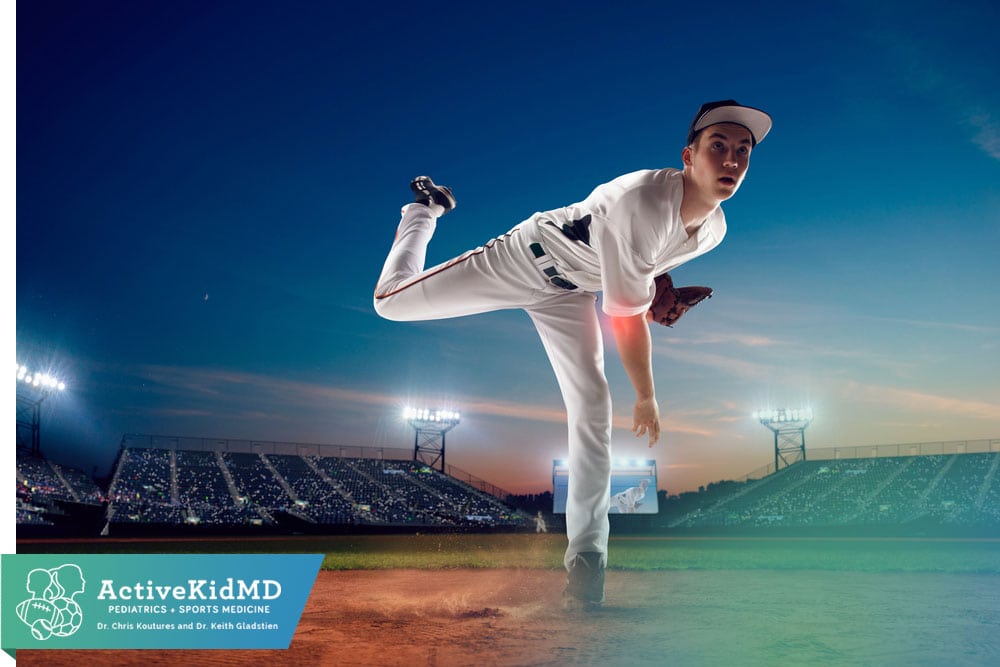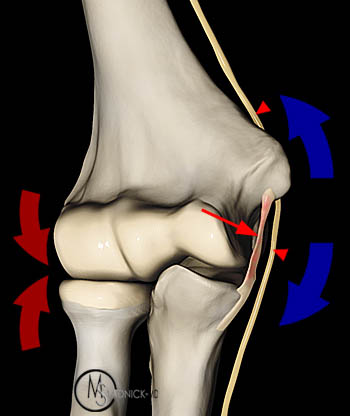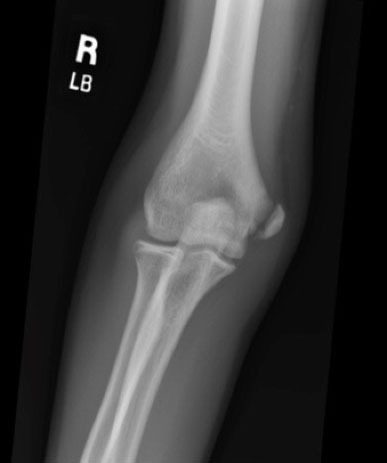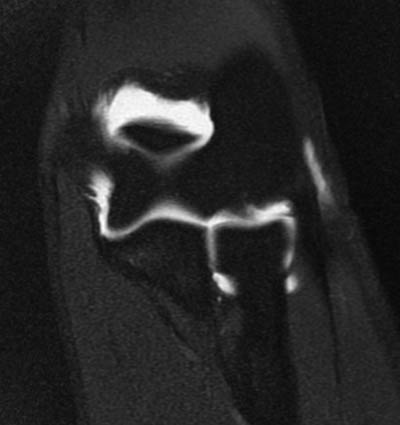
24 Sep Elbow Pain in Baseball Players
Elbow Pain in Baseball Players
Throwing a ball places unique stresses on the elbow. During a throw, structures on the inside of the elbow are stretched (blue arrows in picture). At the same time, structures on the outside of the elbow are pushed together (red arrows in picture). The stretching on the inside tends to happen sooner. With more movement on the inside, there is added compression of the outside of the elbow. That’s in part why pain on the inside is more common than pain on the outside.

Picture courtesy of: radsource.us/ulnar-collateral-ligament-tears-of-the-elbow/
Big red arrows show compression of outside of elbow.
Big blue arrows show stretching of inside of elbow.
Red arrow with stem points to ulnar collateral ligament
Small arrowheads point to ulnar nerve
Now, before we talk more about the elbow, let’s make sure to discuss how the shoulder can add to elbow pain. Decreased shoulder motion, especially internal rotation (follow through), puts additional stress on the inside of the elbow. Weak shoulder muscles including around the scapula (shoulder blade) can lead to dropping the elbow during a throw. This too will put additional stress on the inside of the elbow. The shoulder and elbow link is so important that I routinely evaluate the shoulder FIRST in all throwers.
CLICK HERE TO READ MORE ABOUT SHOULDER ISSUES IN THROWERS.
OK, time to return to the inside of the elbow with a few common “cases”…..
“My child came home from baseball practice with soreness on the inside of the throwing elbow.”
“How can I tell the difference between “normal” pain after throwing and something more serious?”
“What types of elbow pain or soreness need to be seen by a sports medicine specialist?”
Elbow soreness after throwing, especially early in a season, is pretty common. Ideally, there should be no soreness or pain with or after throwing. In reality, I’ll admit that there may be a certain level of soreness after throwing. When do you begin to worry, or really start to worry?
- Pin-point or “finger-tip pain” If a thrower uses a wave of their hand to show me a big area of soreness, that is one level of concern. However, if another thrower uses a fingertip to show me right where it hurts, that is a bigger problem. I tend to take fingertip pain pretty seriously, no matter the joint or body part.
- Pain or soreness that lasts until the day after throwing, for example, waking up with pain, is not “normal” post-throwing soreness
- Swelling or pain that limits a thrower from fully straightening or bending the elbow.
- Elbow pain that leads to poor performance such as not throwing as hard, as accurately, or as often as usual
- Shaking the elbow or taking more time between throws (especially when pitching) due to pain
- Burning or numb feeling on the inside of the elbow
- A pop at the elbow followed by immediate pain and limited movement of the elbow
Pain on the inside of the elbow – what could be the cause?
During a throw, a pitcher feels a painful pop on the inside of the elbow.
There is immediate pain and swelling.
What is the most likely injured part of the inside of the elbow?
The answer depends in great part on the age and maturity of the athlete.
In kids who are still growing (let’s say pre-high school or even early high school age), the biggest concern is the apophysis or growth area.

Picture of an avulsed (separated) growth plate on the inside of the elbow
The stretching forces during throwing can cause abnormal pulling on the growth plate. That immediate painful pop could be an avulsion or pulling off of the growth plate from the rest of the bone.
Repetitive throwing without a “one throw” pop or pain can also cause injury to the growth plate. This type of damage can range from more general growth plate irritation to a partial or full avulsion injury.
Any concern for injury to the growth plate on the inside of the elbow deserves evaluation by a sports medicine specialist. No throwing should occur until after an evaluation and clearance occurs. Growth plates evolve and develop in different times for different throwers. In cases of suspected growth plate injury, x-rays of both elbows are often obtained to compare “normal” elbow to the injured elbow.
In throwers who have finished growing, the “weakest link” may be the ulnar collateral ligament (aka Tommy John ligament).
Throwers with high velocity put higher stresses on this ligament and are at higher risk for injury. The ligament can also be damaged with stretching forces from repeated throwing without that painful “one throw.” Specific physical exam movements may detect abnormal stretching motion due to ligament damage. Often imaging studies such as Magnetic Resonance Imaging (MRI) might be needed to clarify the level of ligament injury.

Picture of a Magnetic Resonance Arthrogram showing a partial tear of an elbow ulnar collateral ligament
Partial or incomplete tears of the ligament may respond to non-surgical care with plenty of physical therapy. Complete or near-complete tears often require surgery and long periods of physical therapy to return to high level throwing.
What other structures tend to be involved with pain on the inside of the elbow?
- Ulnar nerve – Stretching of the inside of the elbow can abnormally stretch the ulnar nerve. Injury to the ulnar nerve can create numbness and tingling. This might be on the inside of the elbow and can also travel down to the ring and pinky fingers. Ulnar nerve injury can also occur with injury to growth plates and/or the ulnar collateral ligament.
- Flexor-pronator muscles – These muscle attachments are located on the inside of the elbow. They contribute to certain motions of the wrist and elbow during throwing. The flexor-pronator muscles do attach to the medial apophysis, so in younger throwers, the growth plate again is the source of the injury, not the muscles.
What positions other than pitcher may be at higher risk for elbow injuries?
Any higher volume throwing position, such as a catcher or shortstop, has a higher risk. In fact, let’s make sure to keep a special eye on those catchers.
CLICK HERE TO LEARN MORE ON HOW TO PROTECT CATCHERS.
The elbow obviously is crucial in the throwing motion. Thus, it is crucial to take seriously any pain on the inside of the elbow.
Contact our office to schedule an evaluation and put together a comprehensive treatment plan.
Steps for Returning to Play After Injury
RELATED CONTENT:
My child is a thrower and doesn’t have elbow pain (awesome!).
How can I best help prevent elbow pain in my young thrower?
CLICK HERE FOR BASEBALL SAFETY TIPS- INCLUDING HOW TO PROTECT YOUNG ARMS!
VIDEO ON YOUTH ARM INJURIES: https://youtu.be/-pgqg3Rm0lc
Following published pitch counts can help prevent elbow pain in young pitchers.
